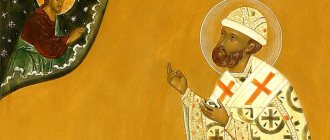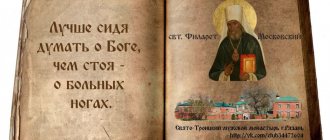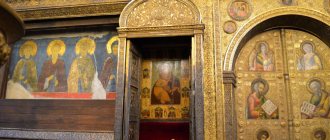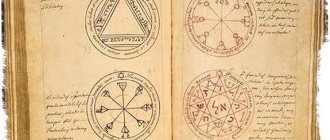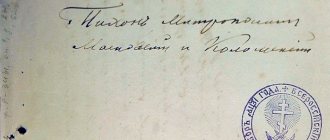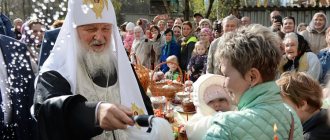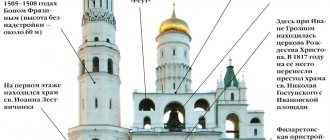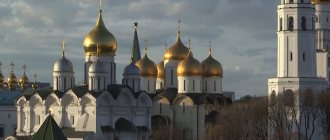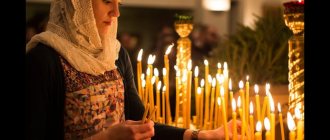On January 5, the Church honors the memory of St. Philip, Metropolitan of Moscow and All Russia . Saint Philip is one of the most significant and tragic figures in Russian history. For the sake of saving people, he was not afraid to go against Tsar Ivan the Terrible. For the sake of establishing the truth, he spoke out against universal lies, against the serving royal shepherds, boyars and other unkind royal entourage. Metropolitan Philip was defrocked, sent to prison and brutally killed. But in his struggle for truth, he emerged victorious.
Origin of the future saint
Philip of Moscow and All Russia came from a noble and ancient boyar family of the Kolychevs, known already in the 13th century. Philip's father, boyar Stefan Ioannovich, was a dignitary at the court of Grand Duke Vasily Ioannovich (1505-1533) and enjoyed his favor and love. However, despite his rank, he was distinguished by rare spiritual qualities: righteousness, courage and mercy. And his wife Varvara, who later took monastic orders with the name Barsanuphia, was a pious woman. On February 11, 1507, their first child was born, whom they named Theodore, this was the future Metropolitan of Moscow and All Russia Philip. Theodore's parents made every effort to give their son the best education.
Pious Varvara placed the seeds of goodness and piety into the child’s pure soul. When Theodore grew up, he was immediately sent to learn to read and write. Book teaching in schools of that time was predominantly church. Theodore took up his studies diligently and soon fell in love with it. Theodore was not attracted by any noisy children's games or the fun of his comrades. Indifferent to worldly entertainment, the God-fearing youth had his own attachments. From the very first steps of his teaching, he fell in love with reading the liturgical books of the Holy Scriptures, the works of the Holy Fathers, and especially the biographies of “former and venerable men who lived before,” from where he learned lessons about righteous living. However, while living in his parents’ house, Theodore did not shy away from worldly activities: he delved into everyday economic affairs and soon acquired very great experience in house-building. This can be seen from the fact that he subsequently proved himself to be an exemplary owner on Solovki.
Theodore, as the son of a noble boyar, was destined for high official activity. He needed to serve in military and court positions. But such activities were not to Theodore’s liking; his heart and mind strove for the thought of God, and all his efforts were aimed at fulfilling the commandments of the Lord.
Chaste, modest and courteous to everyone, Theodore could not therefore get along with his peers. He ran like wildfire from flighty and noble young men with their daring and cheerful pastime, preferring to them older and experienced people, from conversations with whom he tried to gain spiritual benefit. Such sedateness beyond his years, extreme prudence in actions and other good qualities of Theodore aroused everyone's surprise and delighted his pious parents.
Prayers
Troparion to the Moscow saints: Peter, Alexy, Jonah, Philip and Hermogen
The first capitals of Russia, / the guardian of the truth of the apostolic traditions, / the pillars of steadfastness, the mentors of Orthodoxy, / Peter, Alexia, Iono, Philippa and Hermogene, / pray to the Lord of all / to grant greater peace to the universe, / and great mercy to our souls
.
Troparion to Philip II, Met. To the Wonderworker of Moscow and all Russia
Successor of the First Altars, pillar of Orthodoxy, / champion of truth, new confessor, Saint Philip, / laying down his soul for your flock. / Moreover, as if you have boldness towards Christ, / pray for the city and the people who worthily honor your bright memory
.
Troparion for the transfer of relics
A joyful day of bright triumph has risen: / today the depths of the church are expanding, / the inexhaustible treasure of God is receiving spiritual gifts, / an inexhaustible stream of graces, / an abundant source of miracles, / your miraculous and sacred relics, / to St. Philip. / Pray also to the Giver of Christ God, who glorified you / for those who glorify you / and bow down with your sacred relics
.
Close to the king
When Theodore was twenty-six years old, rumors about the good behavior of a young man belonging to one of the noble families reached the royal court. The name of Theodore Kolychev became known to the Grand Duke Vasily himself (March 25, 1479 - December 3, 1533). But soon the prince died. And only after the accession of his son, John IV (August 25, 1530 - March 18, 1584), Theodore was called to serve at the royal court along with other boyar children.
John IV Vasilievich
Because of his excellent qualities, he was soon brought closer to the sovereign, who soon fell in love with Theodore. And this attachment constantly intensified. What a brilliant career awaited this young courtier later! But Theodore could not be seduced by his successes in court life. Having learned humility, obedience and chastity from early childhood, Theodore was not far from deciding to devote himself entirely to serving God. That is why he did not enter into married life at the age at which, according to the custom of the time, others entered into. And soon the hour came when God himself called him to a better life. The reign of Elena Glinskaya (c. 1508 - April 4, 1538), mother of John IV, was full of unrest and discord among the boyars. The autocracy of her favorite, temporary prince Telepnev-Obolensky (d. 1539), aroused the indignation of the sovereign's uncle, Prince Andrei Ivanovich Staritsky (August 5, 1490 - December 11, 1537).
Some of the Kolychev boyars spoke out in his support along with others. Not only was Prince Andrei’s case unsuccessful, but he was also imprisoned, where he died. His followers were also brutally executed. These unfortunate events could not help but have an effect on Theodore's impressionable soul. He began to regret that he had not earlier secluded himself from worldly life. He immediately decided to retire from the bustle of the world. Even in early childhood he heard about Solovetsky Island. It was there that Theodore decided to go. And he was already thirty years old.
On Solovki
In the extremely harsh conditions of the north, working long and hard at economic obediences, Philip tried to retire to the desert to pray. There, according to monastic belief, a bloody Christ appeared to Philip, predicting his future fate and martyrdom.
The brothers repeatedly tried to choose Philip as abbot, but he repeatedly refused. But in 1546 he accepted the abbess and ruled the monastery for 20 years.
Hegumen Philip's craving for solitude and prayer was combined with rare administrative abilities, and the two traditions of the Russian Church - the non-acquisitive Nil of Sorsky and Joseph of Volotsky - were united in his life without conflict.
In the Solovetsky monastery; stamp of a hagiographic icon
St. Philip quickly increased the monastery's land holdings, found rich donors (including the king and his family), and began large-scale construction with the funds received.
Under him, the stone Assumption Church, the refectory chamber, the Transfiguration Cathedral, many outbuildings rose on Solovki, a network of canals arose and several technical devices appeared that made the hard work of the monks easier.
An excellent harbor with a hotel appeared on Bolshoi Zayatsky Island. The monastery library and sacristy were replenished. At the same time, the strict charter developed by Philip did not encourage money-grubbing. The prayer life of the monastery set a good example for other monasteries in the White Sea region.
The beginning of the monastic path. Solovetsky Monastery
Since then, Theodore has continually turned to God in prayer, asking for help and spiritual guidance. Having exchanged the attire of a courtier for the clothes of a commoner, Theodore secretly leaves Moscow, taking with him only bread. Meanwhile, his parents, not knowing where their beloved son had disappeared, searched for him throughout Moscow and surrounding towns and villages. And after a vain search they gave themselves up to inconsolable sadness, considering him dead. But Theodore was already far away then. He sailed across the sea to the holy monastery of Solovetsky.
Solovetsky Monastery. Photo by S.M. Prokudin-Gorsky
Once in place, he received a blessing from Abbot Alexy and accepted the obediences entrusted to him. Soon Theodore was tonsured and named Philip as a monk.
Philip's harsh ascetic life could not hide from general attention; everyone began to talk about him as an exemplary monk, and very soon with his humility and piety he acquired universal love and respect. And his mentor, Elder Jonah, rejoicing for his student, prophetically predicted about him: “This one will be the abbot of our monastery.” With the blessing of the abbot, Philip withdrew from the monastery into the depths of the island, into a deserted and impenetrable forest, and began to live there, invisible to people.
Nine years of Philip's monastic life passed. Alexy, due to his old age and illnesses, wanted to transfer the position of abbot to Philip, his decision was supported by the brethren. Soon Philip was ordained a presbyter. A year and a half later, the abbot of the monastery, Abbot Alexy, passed away. Having buried the elder, the brethren of the monastery, by general advice, as before, began to beg Philip to accept eldership over them. And he, recognizing himself as the legitimate abbot of the monastery, with the blessing of Archbishop Theodosius again accepted the abbess. The newly appointed abbot tried with all his might to raise the spiritual significance of the monastery. He found the image of the Mother of God Hodegetria, brought to the island by the Monk Savatius, and found a stone cross that once stood in front of the saint’s cell. The Psalter that belonged to the Monk Zosima and his vestments were found, in which abbots have since been clothed during services on the days of memory of the wonderworker.
The monastery began to revive spiritually. To streamline life in the monastery, a new charter was adopted. Hegumen Philip built two churches on Solovki: the refectory church of the Assumption of the Mother of God, consecrated in 1557, and the church of the Transfiguration of the Lord. The abbot himself helped lay the walls of the Transfiguration Church. Under its northern porch, he dug a grave for himself, next to the grave of his mentor, Elder Jonah. John and Longinus, the Yarenga wonderworkers, Vassian and Jonah of Pertomina were Philip’s disciples and worked with him among the brethren . For secret prayerful deeds, Philip often retired to a deserted place, two miles from the monastery, which later received the name Philip’s Hermitage.
During the period of his abbess, he drew up the “Charter on Monastic Dress” (“as long as any of the brethren should have clothes and shoes in their cells”). Philip's literary and oratorical talent is evidenced by the accusatory speeches against Ivan the Terrible given in his life. According to researchers, they are based on the authentic speeches of Philip, in which, to give them vivid images, he used quotes from the popular “Teachings of Agapit” in Rus' (a Byzantine monument, known in Russian translation from the 14th century).
Personal life
Before taking monastic vows, Kolychev was not married and had no children. It is possible that Fyodor already from his youth had an inclination towards monastic life, since he entered the monastery at a mature age for those times - 30 years old - and by his age he had never started a family. Most of the boyar's peers at this age were already fathers of many children. At the monastery, Philip took a vow of chastity and kept it until the end of his life. The saint's mother also took monastic vows with the name Barsanuphius.
Murder of M. Philip
Metropolitan of Moscow and All Rus'
In Moscow, Tsar John Vasilyevich, who loved him in his adolescence, remembered the Solovetsky Hermit. He hoped that he would find in Philip a faithful companion, confessor and adviser. The choice of the High Hierarch of the Russian Church seemed to him the best. Philip for a long time refused to take upon himself the great burden of the primate of the Russian Orthodox Church, but nevertheless the tsar managed to persuade the Solovetsky abbot to assume the rank of metropolitan. On July 25, 1566, in the Assumption Cathedral, in the presence of the Tsar and the royal family, the entire court and people, Philip was solemnly ordained as Metropolitan of Moscow and All Rus'.
Assumption Cathedral of the Kremlin
However, Metropolitan Philip did not feel any spiritual closeness with John IV. Philip tried to convince the tsar to stop the repressions and abolish the oprichnina. The tsar, on the contrary, tried to prove to him its state necessity. Finally, Ivan the Terrible and the Metropolitan came to an agreement so that Metropolitan Philip would not interfere in the affairs of the oprichnina and government, not leave the metropolis in cases where the tsar could not fulfill his wishes, and be a support and adviser to the tsar, as the former metropolitans were the support of the Moscow sovereigns .
But a wave of brutal executions that occurred in 1567-1568 led to Philip’s decision to confront Ivan the Terrible. In July 1567, letters from the Polish king Sigismund and the Lithuanian hetman Khotkevich to our most important boyars with an invitation to leave for Lithuania were intercepted. The most terrible executions began. Not only the boyars accused of treason died in terrible agony, but even many citizens suffered. Taking advantage of the unlimited trust of the tsar, armed guardsmen went on a rampage in Moscow under the guise of eradicating sedition. They killed all the people they hated and took away their property.
Ivan the Terrible and Metropolitan Philip. Artist O. Kuzmin
Metropolitan Philip, seeing the incessant atrocities of the guardsmen, finally decided to appeal to the tsar with an exhortation to stop the bloodshed. But before doing this, he tried to attract the shepherds of the Church to this high task, who silently submitted to all the orders of the formidable king. Calling them to self-sacrifice, he told them:
Is this why you, fathers and brothers, have gathered to remain silent, afraid to speak the truth? But your silence leads the princess’s soul into sin and brings the worst destruction to your own soul, and causes grief and confusion to the Orthodox faith. Are you afraid of losing the glory of corruption, but no dignity of this world will save you from eternal torment if we transgress the commandment of Christ and forget our duty to care for the piety of the blessed king, for the peace and prosperity of all Orthodox Christianity. Are you looking at the fact that the royal council is silent? But the boyars are bound by the cares of this life, but the Lord freed us from them. We have been given the right to rule the great truth, even if we lay down our souls for the entrusted flock. You yourself know that you will be tortured for the truth on the day of judgment.
Metropolitan Philip denounces Ivan the Terrible.
Y. P. Turlygin Only Kazan Archbishop German responded to the Metropolitan’s ardent call; he sided with Philip, supporting and sympathizing with him.
Other shepherds were not only frightened, but even tried to interfere and harm the Primate of the Church. It is no coincidence, apparently, that 80 years later the majority of the boyars and archpastors also shut their mouths during the insane church reform of Tsar Alexei Mikhailovich and Patriarch Nikon. And in our years we see how many called to state and spiritual power look indifferently at the lawlessness and suffering of the people.
Metropolitan Philip II Kolychev Fedor Stepanovich
Religious figure. Metropolitan of Moscow and All Rus'. Saint. Before being elected to the Moscow see, he was abbot of the Solovetsky Monastery, where he proved himself to be a capable leader. Due to disagreement with the policies of Ivan IV and open opposition to the oprichnina, he fell into disgrace.
Fyodor Kolychev was born on February 21, 1507 in the city of Moscow. His father Stepan Ivanovich prepared his son for the sovereign service. His mother Varvara raised him in the spirit of Christian piety. The boy was taught to read and write in the books of the Holy Scriptures, as well as to master weapons, horse riding and other military skills. Until the age of thirty he was at the grand-ducal court of Vasily III, gaining the sympathy of the young Ivan IV.
In 1537, Fyodor’s relatives sided with the Staritsky prince Andrei Ivanovich, who rebelled in Novgorod against Elena Glinskaya. The Kolychev family fell into disgrace: uncle Ivan Umnoy-Kolychev went to prison, his second cousins Andrei Ivanovich and Gavrila Vladimirovich were whipped and executed. After this, the saint himself secretly left Moscow.
Without saying goodbye to his family, in the clothes of a commoner, Fyodor Kolychev left Moscow and headed north. In the north of Novgorod land he became exhausted and was forced to stop at Lake Onega. There he was sheltered by a resident of the Onega village of Kizha, Sidor Subota. For some time the saint tended sheep, and then moved to the Solovetsky Islands to the Solovetsky Monastery, where he was accepted as a novice. The abbot assigned him to general work and the scion of the boyar family had to chop wood, dig the ground, and carry stones.
After a year and a half of obedience, Abbot Alexy tonsured Fyodor Stepanovich Kolychev into monasticism with the name Philip. Elder Jonah Shamin, a disciple of St. Alexander of Svir, became the spiritual mentor.
In 1548, the Solovetsky abbot Alexy resigned due to old age, proposing to the monastery council Philip as his successor, who by this time had lived in the monastery for about eight years. By the decision of the council, the saint was elected abbot and elevated to the rank of Novgorod Archbishop Theodosius.
Under him, the monastery followed the communal rules. Philip proved himself to be a competent economic administrator: he built a network of canals between numerous lakes on the island, installed mills on them, erected new economic and industrial structures on the islands and in the Pomeranian estates, and introduced mechanical improvements to the monastic industries. Under him, the Solovetsky Monastery became the industrial and cultural center of Northern Pomerania. Church construction was also actively developing: the Assumption and Transfiguration Cathedrals were built, bells were installed in the monastery instead of bells and rivets, two- and three-story cells and a hospital were erected for the brethren.
Philip did a lot to perpetuate the memory of the founders of the monastery, Saints Zosima and Savvaty. Their wooden tombstone chapels were renewed, large hagiographic icons of each of the saints were ordered, and Tsar Ivan IV sent “two covers of blue-blue satin” for the shrines of the miracle workers. He transferred the relics of these saints to the Transfiguration Cathedral of the monastery. He also began collecting relics associated with the saints: he found an image of the Mother of God Hodegetria, brought to the island by Savvatiy, as well as a stone cross that stood in front of his cell. From the relics of Zosima, I found his Psalter and vestments, in which the Solovetsky abbots have since dressed themselves during divine services on the days of memory of this saint.
During the period of his abbess, Philip often retired to the desert two miles from the monastery, where he spent time in prayer. According to legend, Jesus appeared to him there wearing a crown of thorns and with signs of torture. At the site of the apparition, a spring gushed over which the saint built a chapel.
Also during this period of the abbess, donations to the Solovetsky Monastery from the Tsar and private individuals increased noticeably. In 1548, Ivan IV granted the monastery the Kolezhma volost with saltworks, land and all quitrents, an island on the Suma River with three courtyards, and in 1550 the Soroka River with quitrents. Precious church utensils were also regularly sent to the monastery.
In 1548, by royal charter, the monastery was allowed to conduct duty-free trade in salt for ten thousand poods per year, in 1551 Ivan IV confirmed this right, and in 1555, for an unknown reason, the monastery lost the rights to duty-free trade not only in salt, but also in other goods. In return, the monastery received a number of villages on the Suma River and numerous saltworks on the seashore. All were taxed in favor of the royal treasury, but in 1556, at the request of Philip, the king freed them from the quitrent.
Hegumen Philip was a participant in the Council of the Hundred Heads, became again personally known to the tsar, and after the Council received from him rich church vestments and confirmation of monastic tax benefits. And during his future visits to Moscow, the tsar ordered to give him “feed money” from the treasury. Trinity Abbot Artemy, the leader of the non-covetous party, was exiled to Solovki under the supervision of the abbot. Later, Sylvester, a prominent figure in the “Elected Rada,” was imprisoned in the monastery.
After the candidate for Moscow metropolitan, Archbishop German of Kazan, who expressed disagreement with the policies of Ivan the Terrible, fell into disgrace, Abbot Philip of Solovetsky was offered to take the throne of the Moscow Metropolis. Ivan IV summoned him to Moscow, and at the Council of Bishops on July 20, 1566, he was invited to accept the metropolitan rank. Before giving his consent, the abbot set the condition for the destruction of the oprichnina.
The Tsar did not agree and argued for the need for oprichnina. Philip objected, but, tired of the argument, the king ordered him to be silent. The church hierarchs, at the direction of Ivan, were able to persuade the abbot to yield to the tsar. Before the council, he gave his consent to the election, a conciliar verdict was drawn up, in which Philip “gave his word to the archbishops and bishops that he, by the royal word and with their blessing, agrees to become a metropolitan, that he will not interfere in the cause and the royal household, but once appointed, do not abandon the metropolis for reasons and the royal household.” By a council of all Russian bishops on July 25, 1566, he was consecrated bishop and installed as Metropolitan of Moscow and All Rus'.
As Metropolitan, Philip ruled not only the Moscow diocese, but the entire Russian Church, appointed bishops to all dioceses, supervised their activities, exhorted with messages, but did not have the right to judge them, since this was the prerogative of the church council. In 1567, the Metropolitan convened a church council in which Tsar Ivan IV took part. The reason for convening the council was the death of several hierarchs and the need to resolve the issue of replacing dowager chairs.
Returning in the winter of 1568 from the first Livonian campaign, the king began a new wave of terror. The reason was intercepted letters to the Moscow boyars of the Polish king Sigismund and Hetman Khodkiewicz with a proposal to move to Lithuania. Mass executions began. The first to suffer was the boyar Ivan Chelyadnin and his family, and then, in his treasonous case, the princes Kurakin-Bulgakov, Ryapolovsky, three princes of Rostov, and princes Shchenyatev and Turuntai-Pronsky, who became monks, died.
Events escalated into an open conflict between the king and the spiritual authorities. Philip actively opposed oprichnina terror. At first he tried to stop the lawlessness in private conversations with the tsar, asking for the disgraced, but Ivan the Terrible began to avoid meetings with the metropolitan. The first open clash between the metropolitan and the tsar took place on March 22, 1568 in the Assumption Cathedral of the Kremlin.
Ivan the Terrible, along with his guardsmen, came to the service in black robes and high monastic caps, and after the liturgy he approached Philip for a blessing. The Metropolitan pretended not to notice the Tsar, and only after the boyars asked him to bless Ivan did he address him with an accusatory speech. The next day, new executions began, Prince Vasily Pronsky died. The boyars and service people of the metropolitan court were subjected to torture in order to extract testimony about the metropolitan's plans against the tsar. The king did not dare to raise his hand against Philip himself because of his popular veneration. As a sign of protest, the saint left his residence in the Kremlin, moving to one of the Moscow monasteries.
Philip served in the Novodevichy Convent on July 28, 1568. After the religious procession along the walls of the monastery, he stopped at the Holy Gates of the monastery and had to read the Gospel. Looking around, I saw one of the guardsmen in a tafya, while during the reading of the Gospel it is customary to stand with your head uncovered. The Metropolitan made a remark to the Tsar, but the guardsman quickly removed the taffe, and no one gave him away. Ivan was angry with the saint, calling him a liar, a rebel, a villain. After this incident, the king began preparing a church court in order to get rid of the hierarch he disliked in a canonical way.
At the direction of Ivan IV, an investigative commission was sent to the Solovetsky Monastery to collect incriminating material against Metropolitan Philip. It included Suzdal Bishop Pafnuty, boyar Vasily Temkin-Rostovsky, Archimandrite Feodosius of the Andronikov Monastery and clerk Dmitry Pivov. The commission, in order to obtain evidence from the monks against the metropolitan, acted with threats and bribery. However, the accusation drawn up was so dubious that Bishop Paphnutius even refused to sign it.
An ecclesiastical trial took place in the Assumption Cathedral of the Kremlin, and Novgorod Archbishop Pimen became the main accuser of Philip. The Council of Bishops on November 4, 1568 deprived the saint of his metropolitan rank. However, the tsar did not allow him to leave, ordering him to lead the service in the Assumption Cathedral as a metropolitan on the day of the Archangel Michael.
During a service in the Church of the Assumption in the Kremlin on November 8, 1568, Fyodor Basmanov announced to the Metropolitan that he was deprived of his rank. The guardsmen removed Philip's holy vestments, dressed him in a torn monastic robe, and expelled him from the church. The saint was placed under arrest in the Epiphany Monastery.
A few days later, Saint Philip was brought to listen to the final verdict, by which he was condemned to eternal imprisonment. By order of the Tsar, the Metropolitan’s feet were put into wooden stocks and his hands were shackled in iron shackles. According to the life, all the shackles miraculously fell off him, which was reported to the king, who no longer dared to subject the metropolitan to new torments. He was imprisoned in the monastery of St. Nicholas the Old, then starved to death.
Soon Philip was exiled to the remote Otroch Assumption Monastery in Tver, and Ivan IV executed a number of other Kolychevs. During the Novgorod campaign in 1569, the tsar sent Skuratov to the monastery to ask for blessings for the campaign.
According to his life, on January 2, 1570, Malyuta strangled St. Philip. Leaving the cell, he went to the abbot and began to accuse him of the fact that, due to an oversight, it was so hot in the cell that the saint died of fumes. A hasty funeral took place and the guardsman left the monastery.
In 1591, at the request of the brethren of the Solovetsky Monastery, the relics of Philip were delivered from the Otroch Monastery and buried under the porch of the chapel of Saints Zosima and Savvaty of the Transfiguration Cathedral. At the end of the 16th century, the first life was compiled and his local veneration as a saint began with Memorial Day on January 9.
In 1652, Tsar Alexei Mikhailovich, on the initiative of Metropolitan Nikon of Novgorod and in agreement with Patriarch Joseph, decided to transfer the relics of the saint to Moscow. On July 9, 1652, the relics were solemnly brought to Moscow and on July 19 they were placed in a silver shrine in the Assumption Cathedral near the iconostasis.
Memory of Metropolitan Philip II
Memory of Metropolitan Philip II
Memory is accomplished:
January 22 June 3 - Cathedral of the Karelian Saints June 28 (movable) - Cathedral of the Novgorod Saints July 16 - Transfer of Relics July 19 (progressable) - Cathedral of the Tver Saints August 22 - Cathedral of the Solovetsky Saints October 18 - Cathedral of the Moscow Saints
The first church in the name of St. Philip was built in 1677 in the Meshchanskaya Sloboda at the place where the king met his relics. Initially, the building was wooden, in 1691 the church was rebuilt in stone, and in 1777-1788 the building was rebuilt by the architect Matvey Kazakov and became one of the best examples of Moscow classicism
After the glorification of the saint, churches and chapels in his name began to be built in monasteries (Philipovskaya Church in the Valdai Iversky Monastery, mid-17th century; Filippovskaya chapel and church in the Solovetsky Monastery, late 17th century) and in various cities of the country. In Moscow in 1856, the descendants of the boyar family of the Kolychevs, the Bode-Kolychev barons, built a house church in their estate in the name of the saint, into which they collected ancient icons
According to one version, the appearance of the expression “Filka’s letter” is associated with Metropolitan Philip.
Literature in A. K. Tolstoy’s novel “Prince Silver” (1862) the lullaby is sung about the murder of Philip by Skuratov: “Like him, the evil dog Malyuta, // strangled the holy elder. // Holy Elder Philip!
Kostylev V.I., novel-trilogy “Ivan the Terrible” (1943-47). Metropolitan Philip denounces the tsar and connects the country’s troubles with his policies: “A terrible pestilence has devastated the Russian land. Some were depressed by the thought of doom, of the imminent “end of the world.” Metropolitan Philip frightens the Tsar that “all this is happening because of his sin!”
Nagibin Yu. M. “A Trip to the Islands” (1986), a story about the last years of Philip’s life in the Solovetsky Monastery before his election as metropolitan.
Volodikhin D. M. “Metropolitan Philip” (2007), historical drama with elements of mysticism.
Cinematography In the film “Ivan the Terrible” (1944) by Sergei Eisenstein, the role of Metropolitan Philip is played by Andrei Abrikosov. The saint is shown as a childhood friend of the king, who on his wedding day allows him to take monastic vows. Having returned at the direction of the tsar from Solovki, Philip acts as an opponent of Ivan the Terrible, having fallen under the influence of a boyar conspiracy led by Euphrosyne Staritskaya.
In the film “Tsar Ivan the Terrible” (1991), the role of Metropolitan Philip is played by Galix Kolchitsky (dubbed by Rogvold Sukhoverko).
In the film “The Thunderstorm over Russia” (1992), the role of Metropolitan Philip is played by Vaclav Dvorzhetsky.
In the television series “Ivan the Terrible” (2009), the role of Metropolitan Philip is played by Valery Nikitin
In Pavel Lungin’s film “The Tsar” (2009), dedicated to the confrontation between Ivan the Terrible and Metropolitan Philip, Oleg Yankovsky starred in the role of the saint (the actor’s last role).
30.11.2020
Exposing the Tsar's lies
In the fall of 1567, the tsar set out on a campaign against Livonia, and it was then that he became aware of the boyar conspiracy. The traitors intended to capture the king and hand him over to the Polish king, who had already moved troops to the Russian border. Ivan the Terrible dealt harshly with the conspirators, and again a lot of blood was shed. On the Week of the Worship of the Cross, March 2, 1568, when the Tsar and the guardsmen came to the Assumption Cathedral, as usual, in monastic vestments, Metropolitan Philip refused to bless him and began to openly condemn the lawlessness that the guardsmen committed: “Metropolitan Philip taught with the sovereign in Moscow to be at enmity about oprichnina." The Bishop’s denunciation interrupted the splendor of the church service. Tsar Ivan the Terrible said in anger: “Are you resisting us? Let's see your strength! “I was too soft on you.”
Metropolitan Philip refuses to bless Ivan the Terrible. V. V. Pukirev
Church trial of Metropolitan Philip
The king began to show even greater cruelty in persecuting everyone who opposed him. The executions followed one after another. The fate of the Metropolitan Confessor was decided. But Ivan the Terrible wanted to maintain the canonical order. The Boyar Duma obediently made a decision on the trial of the Head of the Russian Church. A cathedral trial was held over Metropolitan Philip in the presence of the thinned Boyar Duma. It was November 4th.
Arrest of Metropolitan Philip. Artist Sergey Shelkovy
At the appointed hour, the sovereign himself and the innocently accused high priest arrived; dressed in holy robes, he appeared for trial. The reading of denunciations began, but there were no accusers, for the king was afraid to confront the saint with the slanderers. After reading the denunciations, they stopped to listen to the accused. Philip, considering it unnecessary to justify himself, for he knew that his fate had already been decided in advance, turned to the king with the following words:
Sovereign and Grand Duke! Do you think I'm afraid of you or death? No! It is better to die an innocent martyr than to silently endure all these horrors of lawlessness in the rank of metropolitan. Do whatever you want. Here is the pastoral staff, here is the hood and mantle with which you wanted to exalt me. And you, servants of the altar,” the saint continued, turning to the bishops, “faithfully shepherd the flock of Christ: prepare to give an answer to God and fear the Heavenly King more than the earthly one.
Having said these words, Saint Philip took off the signs of his dignity and wanted to leave, but the king stopped him, saying that he should still await a council decision, and not be his own judge. He forced him to take back the saint’s clothes and still serve mass on November 8th. It was the feast of Archangel Michael. Metropolitan Philip, in full holy vestments, was serving the Liturgy in the Assumption Cathedral, when suddenly the church doors opened with a noise and the Tsar’s favorite Alexei Basmanov entered the cathedral with a crowd of soldiers and guardsmen. Basmanov ordered the royal decree and the council’s verdict on the deposition of the metropolitan to be read aloud in front of all the people, and all the slander against him was read out. At the end of the reading, those who came furiously rushed at the saint and began to tear off his sacred clothes. Metropolitan Philip was not disturbed in spirit and tried to calm his clergy. Throwing the tattered and dirty cassock of a simple monk over Philip's shoulders, the guardsmen dragged him out of the temple, beat him on the head with brooms, put him on a log and, showering him with abuse and beatings, took him to the Epiphany Monastery. Before the gates of the monastery, Saint Philip addressed the flock around him for the last time with comforting words:
I accepted all this for your good, so that your confusion may be pacified. If it were not for my love for you, I would not have wanted to stay here for a single day, but the word of God held me back: The good shepherd lays down his life for the sheep (John 10:11).
At the same time, the metropolitan’s prophetic words about the fate of the Russian Church were heard:
O children, this separation is sorrowful, but I rejoice that I acquired this for the sake of the Church; the time has come for her widowhood, for shepherds, like mercenaries, will be despised. They will not hold their pulpit here and will not be buried in their cathedral church of the Mother of God.
This prophecy was finally fulfilled several decades later. During the reforms of Patriarch Nikon, when most of the archpastors behaved like “mercenaries”, fell away from the right faith and a period of widowhood began in the Church. Having accepted the last blessing from the saint, the people went home in confusion, and Philip was imprisoned in the monastery. “The martyr was languished for a long time in the basements of Moscow monasteries, the elder’s legs were driven into stocks, he was kept in chains, and a heavy chain was thrown around his neck.” Finally, they were taken to captivity in the Tverskaya Otroch Monastery.
Tverskoy Assumption Monastery
Murder of the disgraced Metropolitan
About a year passed since Saint Philip was in captivity. In December 1569, Tsar Ivan the Terrible moved with an army to Novgorod to punish him for imaginary treason. When he approached Tver, he remembered Metropolitan Philip, imprisoned here, and sent the most evil of his guardsmen, Malyuta Skuratov, supposedly for a blessing.
Metropolitan Philip is in captivity. Fragment of an icon
Philip, anticipating his death, said to those around him: “The time has come to accomplish my feat; my departure is near.” And, having received the Holy Mysteries, he calmly awaited his end. Malyuta entered the cell and, humbly bowing, said to the saint: “Vladyka, give your blessing to the king to go to Veliky Novgorod.”
A. Novoskoltsev. The last minutes of the life of Metropolitan Philip
Knowing why the royal messenger came, Saint Philip answered him: “Do what you came to me for, and do not tempt me by flattery asking for the gift of God.” Immediately the disgraced metropolitan turned to God in prayer.
Metropolitan Philip and Malyuta Skuratov. Nikolai Nevrev, 1898
Malyuta took a pillow and strangled Saint Philip with it. Then he hastily left the cell and, having informed the abbot and the brethren of his death, began to reproach them for neglecting the prisoner, who allegedly died from excessive intoxication in the cell. Malyuta ordered to dig a deep hole behind the altar of the cathedral church and bury the long-suffering body of Saint Christ there. At the same time, there was neither the ringing of bells, nor the fragrance of incense, nor, perhaps, the very singing of the church, for the evil guardsman was in a hurry to hide the traces of his crime. And as soon as the grave was razed to the ground, he immediately left the monastery.
Malyuta Skuratov kills Metropolitan Philip. Fragment of the icon of St. Philip
But soon the wrath of God befell the persecutors of the martyred metropolitan. Malyuta Skuratov was soon killed. The king's wrath befell all the shepherds who slandered Philip, tormented him, and turned away from him in the days of grave trials.
